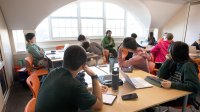Using Breakout Seminars in High School to Encourage Critical Thinking
An interactive learning experience rooted in open communication helps students collaboratively explore new concepts.
Your content has been saved!
Go to My Saved Content.As a high school American history teacher, I transitioned this fall to breakout seminars, departing from full-class discussions to embrace a format that fosters intimate and in-depth exploration of topics. This shift aims to facilitate a more interactive learning experience, enabling students to delve into various aspects of history within smaller, more focused groups.
In my classes, which typically consist of 15–17 students, the breakout-seminar-style approach has been notably effective. One student, in an anonymous survey, shared, “The smaller group size has allowed me to delve much deeper into the subject matter. I feel more comfortable expressing my thoughts and ideas, and the discussions are more focused and meaningful.”
This feedback aligns with my observation; in breakout seminars, many students are more at ease in articulating their thoughts and analyzing texts. Such engagement also supports critical thinking and the development of personal interpretations. As students grow more confident in these discussions, their proficiency in identifying and dissecting key passages improves correspondingly.
This skill seamlessly transfers to analytical writing, where one’s capacity to adduce compelling evidence is paramount in supporting an argument. Another student shared, “I find myself being more selective of which quotes to include, not only in history but also in other classes.” Music to my ears!
Shaping Respectful and Engaged Learning Environments
I set clear expectations for my students, focusing on the importance of respectful dialogue and thoughtful engagement. I led by example, modeling these behaviors to establish a learning environment conducive to hearing and valuing diverse opinions. This approach requires a space where students feel comfortable expressing their ideas, especially on complex and sensitive topics.
Recognizing the challenges of addressing intricate subjects such as enslavement, I occasionally invite colleagues to collaborate in overseeing breakout seminars. Their presence proves invaluable in maintaining focused and respectful discussions. This strategy also brings a broader perspective and additional guidance to facilitate sensitive conversations.
Balancing adult supervision with student autonomy is a crucial aspect of my teaching approach. It involves trusting students to engage independently in debates and discussions while being prepared to intervene when necessary to maintain a constructive and respectful environment. This balance is particularly crucial when addressing delicate subjects that may require guidance and oversight.
For example, in students’ discussions of Harriet Jacobs’s Incidents in the Life of a Slave Girl, I first led a full-class seminar to ensure a comprehensive understanding of the topic’s significance and sensitivity. This initial seminar allowed students to express their thoughts and provided a foundation for the subsequent breakout sessions. It also reinforced the importance of approaching such topics with sensitivity, respect, and responsibility.
Through these methods, I aim to create a learning environment that values student agency and independence while providing the necessary support and guidance to navigate challenging issues. This approach underlines my commitment to cultivating a respectful, thoughtful, and inclusive classroom dynamic.
Empowering Students through Self-Assessment
Self-assessment is also a vital component of the breakout-seminar approach, playing a significant role in building student autonomy and trust. Central to this method is the “Summits and Deltas” concept, gleaned from my experience while teaching an online American history course at One Schoolhouse. For a summit, students are encouraged to engage in critical reflection about a unit’s highlights—focusing on what they found most enjoyable and personally fulfilling. In contrast, identifying a delta involves pinpointing an area that fell short of their expectations, with a view toward enhancing this aspect in the subsequent unit. This approach transcends mere evaluation; it acknowledges students’ capacity for meaningful self-reflection, solidifying the confidence placed in their self-assessment skills.
While vocal participation is required to earn up to full credit, my self-assessment includes a section for quieter students, or those less comfortable in spoken discussions, to express their understanding in writing. As an introvert, I empathize with the challenge of encouraging introverted students to participate more vocally while being fair in grading if they struggle.
The impact of this self-assessment process is illustrated by another student’s reflection: “The Summits and Deltas exercise really opened my eyes. I realized I’m good at researching but need to work on speaking up. Knowing this has given me a clear direction [for] what to focus on next.”
Such feedback highlights the effectiveness of self-assessment in helping students identify their strengths and weaknesses, providing them with clarity and a sense of direction in their educational journey.
Adapting Breakout Seminars for Diverse Educational Settings
At my school, I am privileged with ample space and resources to facilitate breakout seminars. However, this approach can be more challenging in different settings because of logistical complexities and heightened supervisory needs.
In many cases, securing additional staff to aid in breakout seminars may not be practical. If it becomes a viable option, enlist support—even if only once or on an occasional basis.
If students have laptops and internet access, recommend video or written responses (anonymous or credited). Otherwise, use traditional methods like chalkboard or large paper for group ideas. Regardless of the setting, the primary goal is the same—to establish a robust foundation of trust among students. This trust is essential for managing an environment that supports open and thoughtful discussions.
